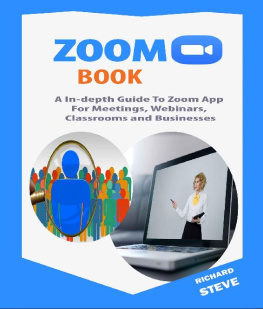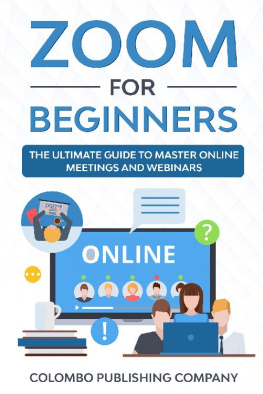ZOOM
2020 Beginners Guide
George Coleman
Copyright 2020 by George Coleman
All rights reserved.
This document is geared towards providing exact and reliable information with regards to the topic and issue covered. The publication is sold with the idea that the publisher is not required to render accounting, officially permitted, or otherwise, qualified services. If advice is necessary, legal or professional, a practiced individual in the profession should be ordered.
- From a Declaration of Principles which was accepted and approved equally by a Committee of the American Bar Association and a Committee of Publishers and Associations.
In no way is it legal to reproduce, duplicate, or transmit any part of this document in either electronic means or in printed format. Recording of this publication is strictly prohibited and any storage of this document is not allowed unless with written permission from the publisher. All rights reserved.
The information provided herein is stated to be truthful and consistent, in that any liability, in terms of inattention or otherwise, by any usage or abuse of any policies, processes, or directions contained within is the solitary and utter responsibility of the recipient reader. Under no circumstances will any legal responsibility or blame be held against the publisher for any reparation, damages, or monetary loss due to the information herein, either directly or indirectly.
Respective authors own all copyrights not held by the publisher.
The information herein is offered for informational purposes solely, and is universal as so. The presentation of the information is without contract or any type of guarantee assurance.
The trademarks that are used are without any consent, and the publication of the trademark is without permission or backing by the trademark owner. All trademarks and brands within this book are for clarifying purposes only and are the owned by the owners themselves, not affiliated with this document
Table of Contents
Introduction
Zoom Video Communications, Inc. (Zoom) is an American communications Tech Organization headquartered in San Jose, California. It supplies internet chat services and telephony via a cloud-based software platform that is peer-reviewed and can be used for telecommuting teleconferencing, distance education, and social connections. Zoom's business plan focuses on using a high amount of employee efficacy and also providing cost savings, including decreasing costs, in addition to an easier to use product than rivals. Eric Yuan, executive, and a Cisco WebEx engineer launched its own applications, also based Zoom in 2011. Zoom's aggressive earnings growth, and sensed ease-of-use and reliability of its applications, led to a $1 billion valuation in 2017, which makes it a "unicorn" business. The business completed an initial public offering and became profitable in 2019. The business combined the NASDAQ-100 inventory index on April 30, 2020. Starting in 2020, the software use of Zoom saw a substantial increase after the introduction of measures adopted in reaction. Scrutiny has been confronted by its software products linked to privacy and safety problems. Some of the workforces of Zoom are based in China that has given rise to censorship and surveillance concerns. It unifies cloud group messaging to a platform, online meetings, and conferencing. It offers sound, the ideal video and wireless experience across multiple programs. Video sessions in Zoom are much like sessions conducted in a classroom, in which groups of pupils meet to innovate. You're able to set sessions on your Zoom assembly room, to take part in personal, real-time, and group talks. Within a session, team members communicate through the net or by telephone, chat, annotate, may share info, and move to a different presenter. As a host, you can combine a session of your decision facilitate or to see group interactions.
Chapter 1 Zoom And Its Core Services
How This Function Can And Zooming
Zoom is to meet together while running chats, by audio-only or video, or both, and it allows you to list those sessions to see. More than half of Fortune 500 companies utilized Zoom in 2019. You hear these phrases: Zoom Room and Zoom Meeting when people are speaking about Zoom. Zoom Meeting refers that it is hosted with Zoom. It's possible to combine these meetings through a telephone or a webcam. Meanwhile, there is a Zoom Room, your hardware setup that allows businesses to start and schedule Zoom Meetings. Zoom Rooms are a perfect solution for businesses that are larger and need an extra subscription.
History
Historical Years
Eric Yuan set Zoom to get Cisco WebEx. He left Cisco in April 2011 with 40 engineers to begin a new firm, initially called Saasbee, Inc. Since people believed the market was saturated, the company had difficulty finding investors. In June 2011, the business raised $3 million of seed money in WebEx creator Sub rah Iyar, former Cisco SVP and General Counsel Dan Scheinman, and venture capitalists Matt Ocko, TSVC, along with Bill Tai. Its title changed to Zoom in May 2012. Back in September 2012, Zoom established a version that may host conferences with up to 15 participants that were video. In November 2012, the business signed Stanford University as its first client. The agency was started in January 2013 following the company raised a $6 million Series A round from Qualcomm Ventures, Yahoo! founder Jerry Yang, WebEx creator Sub rah Iyar, also former Cisco SVP and General Counsel Dan Scheinman. Zoom launched version 1.0 of this program allowing the maximum amount of participants per conference to become 25. From the end of its first month, Zoom had 400,000 users and 1 million consumers, respectively.
Development
With B2B, Zoom based partnerships in July 2013 Collaboration applications suppliers, for example, Red booth (subsequently Team box), and created a program called Works together with Zoom, which based partnerships with Logitech, Vaddio, and InFocus. In September 2013, the business increased to $6.5 million in a Series B round from Facebook, Waze, and Present investors. At that moment, it had 3 million consumers. From June 2014, Zoom had 10 million consumers. On February 4, 2015, the business obtained US$30 million in Series C financing from investors such as Emergence Capital, Horizons Ventures (Li Ka-Shing), Qualcomm Ventures, Jerry Yang, and Patrick Soon-Shiong. With 65,000 organizations, Zoom had 40 million consumers, at that moment. Throughout 2015 and 2016, the company integrated Skype and its software for business. With version 2.5 in October 2015, Zoom improved the maximum number of participants allowed in each convention to 50 and after to 1,000 for company clients. In November 2015, president of Ring Central, David Berman, was appointed president of the business. Also, Peter Gassner, CEO and the creator of both Veeva Systems, combined the board of supervisors of Zoom. From Sequoia Capital in a US$ 1 billion evaluation, the business increased US$ 100 million in January 2017, which makes it a unicorn. Zoom started a tale health product that was scalable, enabling physicians to host consultations. In May, Zoom declared integration with Polycom's conferencing programs, allowing features like multiple display and apparatus meetings, HD and wireless display sharing, and calendar integration with Microsoft Outlook, Google Calendar, and iCal. By September 25-27, 2017, its first user conference, Zoomtopia 2017, was hosted by Zoom. At this summit, Zoom announced a partnership with Meta to incorporate Zoom with augmented reality integration using Slack and Workplace from Facebook and initial steps towards an artificial intelligence speech recognition app.
IPO And Forward
The business became a public company via an initial public offering. After pricing in US$ 36 percent share, 72% climbed over on the initial day of trading. The business was valued at US$16 billion from the end of its first day of trading. Before the IPO, $5 million was spent by Dropbox in Zoom. Zoom found a significant increase in distance education, work, and social connections. Thousands of institutions shifted using Zoom. The business provided its services for free 12 schools in several nations. From February 2020, Zoom had gained 2.22 million consumers in 2020 than it gathered from the entirety of 2019. On a single afternoon in March 2020, the Zoom program was downloaded on 2.13 million occasions. Average users climbed to over 300 million assembly participants in April 2020 from roughly 10 million in December 2019. This resulted in a growth in the stock price of the company despite a stock exchange downturn in 2020. Inventory went by the end of March to $150 per share from less than $70 per share in January 2020. In June 2020, the business valued at over $67 billion. On May 7, 2020, Zoom declared that it had obtained a firm specializing in encryption, Key foundation.













